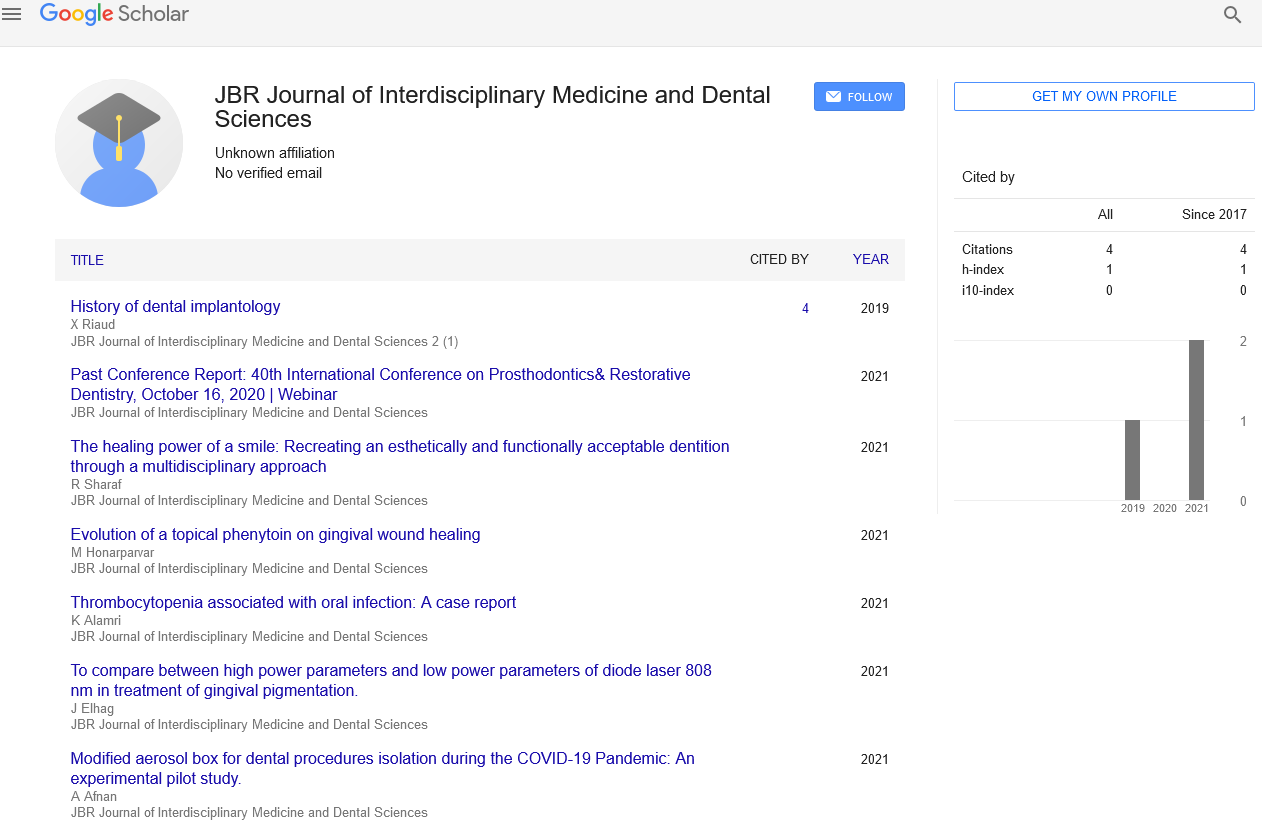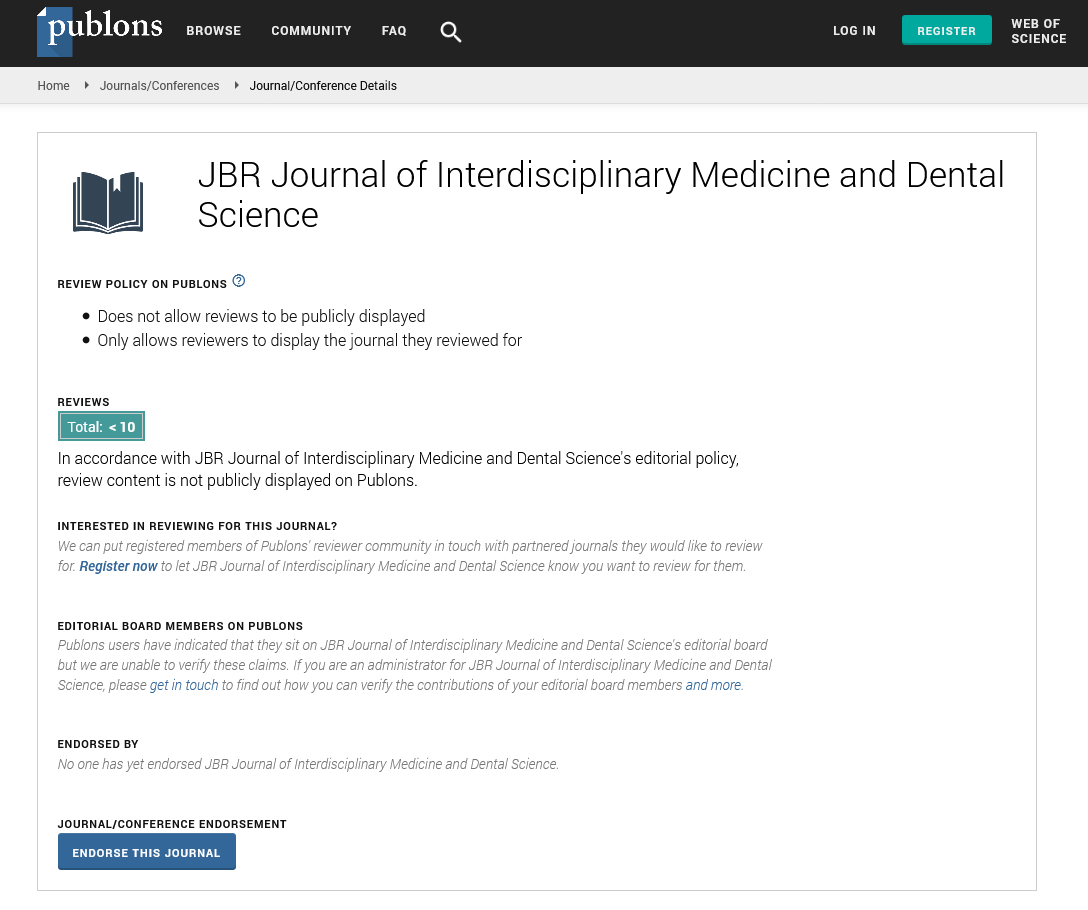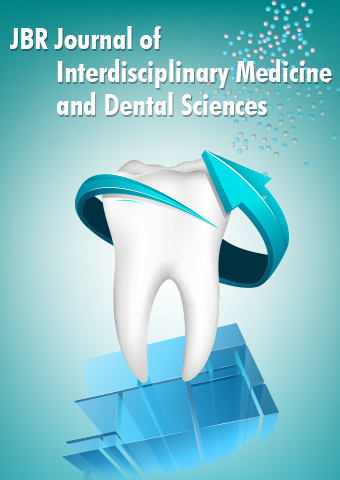Review Article - JBR Journal of Interdisciplinary Medicine and Dental Sciences (2023) Volume 6, Issue 2
Indonesian Medical Professionals' Perceptions On and Interactions with Traditional and Alternative Therapies for Blood Cancer
Lata Argraval*
Department of Oncology and Hematology, University of Sophiahemmet, Sweden
Department of Oncology and Hematology, University of Sophiahemmet, Sweden
E-mail: Lata5agraval3@gmail.com
Received: 02-Mar-2023, Manuscript No. JIMDS-23-93521; Editor assigned: 04-Mar-2023, PreQC No. JIMDS-23-93521(PQ); Reviewed: 18-Mar-2023, QC No. JIMDS-23-93521; Revised: 23-Mar-2023, Manuscript No. JIMDS-23-93521(R); Published: 30-Mar-2023, DOI: 10.37532/2376- 032X.2023.6(2).29-31
Abstract
Traditional and complementary medicine is frequently used to treat children cancer. In order to successfully treat children cancer and prevent patients from discontinuing traditional cancer treatment, effective communication about T&CM is essential. This study investigated how healthcare professionals perceived and communicated T&CM in the treatment of paediatric cancer. Methods a cross-sectional study utilising semi-structured questionnaires at an academic hospital in Indonesia 175 HCP participated in total. Just 2% of HCP say they have a favourable opinion of T&CM. Most HCP believe that T&CM is used by their cancer patients. Giving vulnerable patients false optimism, a lack of proof that T&CM works and their own poor T&CM understandings are the main concerns with HCP’s T&CM. Much more doctors than other HCP are worried about their lack of T&CM expertise. The majority of HCP believe that parents should receive advice from hospital experts regarding the potential positive and negative effects of T&CM. HCP believe it’s crucial for parents to let them know if their cancer-stricken child utilises T&CM. Yet, only 5% of HCP consistently enquire about parents’ use of T&CM. The majority of HCP believe that parents are hesitant to tell doctors they use T&CM, thus they choose not to tell them out of concern that they will receive less care (55%). According to 31% of HCP, parents do in fact receive less care from doctors if they express an interest in T&CM. HCP should brush up on their understanding of T&CM. Physicians ought to be honest with parents about T&CM without punishing them following T&CM revelation.
Keywords
Complementary alternative medicine ▪ Cancer ▪ Health-care providers ▪ Communication
Introduction
In high-income nations, survival rates for children cancer can reach 80%, although they are often less than 35% in low- and middle-income nations [1]. This significant difference in survival rates is primarily attributable to the latter countries’ noncompliance with standard paediatric cancer therapy [2]. It concerns healthcare professionals as well as patients’ carers and patients [3]. Doctors employed full-time in public hospitals in several low- and middle-income nations work during regular business hours in private practises or clinics [4]. Due to this absenteeism in public hospitals, HCPs fail to follow the recommended cancer treatment protocols in a number of ways, including by delaying the diagnosis and beginning of cancer therapy and by having insufficient time to explain the illness, address health beliefs, and deal w it stress [5]. The importance of finishing the standard cancer therapy to families [6]. Caretakers and patients may not follow to treatment plans for a variety of reasons, including parental scepticism about conventional medicine’s ability to treat childhood cancer and a preference for alternative and complementary therapies [7]. There is ample evidence in the literature that T&CM is frequently used by cancer-stricken kids all over the world [8]. According to a comprehensive international analysis, T&CM is more common than 40% of the time in children with cancer, with a range of 6% to 91% [9]. The median T&CM prevalence is higher in low- and middle-income nations than in high-income nations [10]. Different T&CM definitions, short sample sizes, and varying socioeconomic and cultural backgrounds all have an impact on reported T&CM prevalence differences [11]. 80% of paediatric oncology patients at the Dr. Sardjito Hospital in Java, Indonesia, used T&CM. Despite its widespread use, it is still debatable whether T&CM should be discussed with cancer patients [12]. There haven’t been many research addressing HCP perspectives on T&CM. Due to a lack of support for its efficacy and parents’ own ignorance of T&CM’s possible hazards, HCPs at Dr. Sardjito Hospital discouraged parents from using T&CM. Nonetheless, a guideline for the use of T&CM was issued by the SIOP Working Committee on Psychosocial Problems in Pediatric Oncology, and it indicates that HCP should not discourage the use of non-harmful T&CM. Sadly; there are presently few clinical studies on its effectiveness or safety.
Discussion
Communication becomes essential when parents’ and HCP’s perceptions on T&CM in childhood cancer diverge. Families may make decisions, particularly in low- and middleincome nations like Indonesia should switch to T&CM instead of standard cancer treatment. Open communication between HCP and families could have avoided needless cancerrelated fatalities in the first place. To avoid negative interactions and subpar treatment results, any advantages and disadvantages of T&CM in conventional cancer treatment ought to be clearly explored. To further understand how HCPs communicate about T&CM, more research is needed. The purpose of this study was to investigate how HCPs perceive and communicate about T&CM in the treatment of paediatric cancer. Investigations focused on general opinions on T&CM, parental T&CM use, doctor-parent communication concerning T&CM, referral to T&CM practitioners, and doctor-T&CM practitioner communication. Indonesia’s 254 million citizens, who reside in a lower middle-income country, live below the poverty line. An inpatient clinic, day care facility, and outpatient clinic are all part of the pediatric Hematology oncology facilities. There are beds and 4 classes in the paediatric oncology ward: VIP, First Class, Second Class, and Third Class. When rank rises, ward facilities improve, beds per room decrease, and skilled doctors’ individualised care increases. The majority of patients are underprivileged and receive third-class care. The department of paediatric oncology is led by four paediatric oncologists. Throughout their medical training, paediatric residents rotate between various paediatric subspecialties. Oncology and haematology facilities the occupants work for a month. During night and weekend shifts, residents also provide emergency and intensive care for children with cancer. The Hematologyoncology inpatient, outpatient, and childcare facilities each employ two or three nurses per shift. Children with cancer are cared for at the inpatient and outpatient clinic by psychologists and dieticians. The majority of patients are forced to pay for their medical expenses out of their own pockets since they cannot afford private health insurance plans or obtain governmentsubsidized insurance for those who fall below the poverty level. A semistructured survey was used to perform this cross-sectional investigation. General attitudes towards T&CM, parental usage of T&CM, doctor-parent communication about T&CM, referral to T&CM practitioners, and doctoreT&CM practitioner communication about T&CM were all evaluated by the questionnaire. There were both closed- and open-ended questions in it. The closed-ended questions were rated on a scale of two, three, or four points. The questionnaire took 30e45 minutes to complete. From December 2013 to October 2014, every HCP who works in the paediatric department was personally called and invited to complete the questionnaire at home or at the hospital. Using the survey Participants received an assurance that their answers would be treated in confidence and that the survey was anonymous.
Conclusion
The participants’ occupations—pediatric oncologist, resident, nurse, clinical psychologist, or dietician were the only demographic factor that was reported. Two types of HCP were identified by definition. “Doctors” included residents and paediatric oncologists. Nurses, clinical psychologists, and dieticians were included under “Other HCP.” To illustrate the many roles and interactions that HCP have with patients, their professional backgrounds were divided into two categories. While “other HCP” are actively involved in everyday patient care, “doctors” are directly in charge of patient management. The questionnaire was created by a group of medical professionals from Indonesia, the Netherlands, and Indonesia following a thorough review of the literature. The survey was initially created in English and then translated into Indonesian by two people. Two translators, who then reversed the translation into an English version. Five HCP were subjected to a pilot test to make sure the language was clear. Afterward, a few minor changes were made. All prospective participants signed informed permission forms after being made aware of the study’s objectives. The Medical Ethics Committee of Universities Gadjah Mada approved the study’s conduct. The version of IBM SPSS Statistics for Macintosh was used to analyse the data. Calculations were made for frequency counts and percentages. Fisher’s exact, chi-squared, and Mann-Whitney tests evaluated variations in T&CM communication between medical professionals and other HCP. Statistical significance was defined as a 2-sided P-value of 0.05 or less. HCP at a university hospital in Indonesia are aware that their cancer patients utilise T&CM but choose not to disclose this. About all HCP agreed that parents should get advice from hospital doctors regarding the advantages and disadvantages of T&CM. Nonetheless, most HCP acknowledge that their understanding of T&CM is insufficient. This might make it more difficult to talk openly about T&CM with families. To avoid parents from forgoing traditional cancer therapy in favour of T&CM, however, effective up-front communication about T&CM between the parents and the HCP is essential. It is extremely astounding that the majority of HCP in our study have unfavourable opinions on T&CM. Traditional medicine has a lengthy history in Indonesia, just like it does in other Asian and African nations. T&CM is a daily practise and a primary option for rather, it results from a person who is a significant contributor to society having a mind-body-soul imbalance. Despite the prominence of T&CM in Asia and Africa, studies show that conventional HCP in these regions are dubious about T&CM. This may be explained by the Western educational model used in their institutions, which pays little attention to T&CM.
References
- Torre LA, Siegel RL, Ward EM et al. Global cancer incidence and mortality rates and trends--an update. Cancer Epidemiol Biomarkers Prev. 25, 16-27 (2016).
- Sankaranarayanan R Screening for cancer in low- and middle-income countries. Ann Glob Health. 80, 412–417 (2014).
- Plummer M, de Martel C, Vignat J et al. Global burden of cancers attributable to infections in 2012: A synthetic analysis. Lancet Glob Health. 4, e609-e616 (2016).
- Bray F, Ferlay J, Soerjomataram I et al. Global cancer statistics 2018: GLOBOCAN estimates of incidence and mortality worldwide for 36 cancers in 185 countries. CA Cancer J Clin 68, 394-424 (2018).
- Danaei G, Vander Hoorn S, Lopez AD et al. Causes of cancer in the world: Comparative risk assessment of nine behavioural and environmental risk factors. Lancet. 366, 1784-1793 (2005).
- Forouzanfar MH, Alexander LT, Anderson HR et al. Global, regional, and national comparative risk assessment of 79 behavioural, environmental and occupational, and metabolic risks or clusters of risks in 188 countries, 1990-2013: A systematic analysis for the Global Burden of Disease Study 2013. Lancet. 386, 2287-2323 (2015).
- De Martel C, Ferlay J, Franceschi S et al. Global burden of cancers attributable to infections in 2008: A review and synthetic analysis. Lancet Oncol. 13, 607-615 (2012).
- Plummer M, Franceschi S, Vignat J et al. Global burden of gastric cancer attributable to Helicobacter pylori. Int J Cancer. 136, 487-490 (2015).
- Maucort Boulch D, de Martel C, Franceschi S et al. Fraction and incidence of liver cancer attributable to hepatitis B and C viruses worldwide. Int J Cancer. 142, 2471-2477 (2018).
- Andermann A, Blancquaert I, Beauchamp S et al. Revisiting Wilson and Jungner in the genomic age: A review of screening criteria over the past 40 years. Bull World Health Organ. 86, 317-319 (2008).
- Lantz PM, Dupuis L, Reding D et al. Peer discussions of cancer among Hispanic migrant farm workers. Public Health Rep. 109, 512-520 (1994).
- Ajekigbe AT Fear of mastectomy: The most common factor responsible for late presentation of carcinoma of the breast in Nigeria.Clin Oncol R Coll Radio 3, 78-80 (1991).
Indexed at, Crossref, Google Scholar
Indexed at, Crossref, Google Scholar
Indexed at, Crossref, Google Scholar
Indexed at, Crossref, Google Scholar
Indexed at, Crossref, Google Scholar
Indexed at, Crossref, Google Scholar
Indexed at, Crossref, Google Scholar
Indexed at, Crossref, Google Scholar
Indexed at, Crossref, Google Scholar
Indexed at, Crossref, Google Scholar
Indexed at, Crossref, Google Scholar


